|
 Entoloma squamiferum Entoloma squamiferum
SynonymsEntoloma acuticystidiosum
BiostatusPresent in region - Indigenous. Endemic
Images (click to enlarge)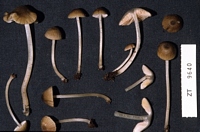
Caption: ZT9640: Entoloma acuticystidiosum
Owner: Egon Horak | 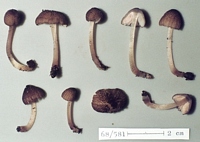
Caption: 68/581: ENTOLOMA ACUTICYSTIDIOSUM
Owner: Egon Horak | 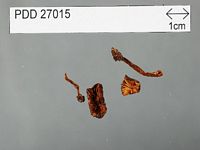
Caption: Dried type specimen
Owner: Herb PDD | 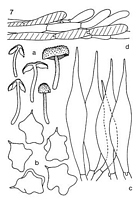
Caption: Entoloma acuticystidiosum Hk. (holotype): a. carpophores. b. spores. c. cheilocystidia.
d. cuticle. | 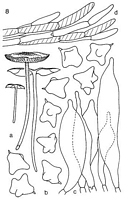
Caption: Entoloma squamifer Hk. (holotype):
a. carpophores. b. spores. c. cheilocystidia. d. cuticle | 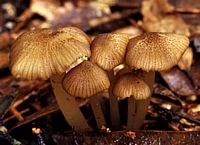
Caption: Entoloma squamiferum
Owner: Kaimai Bush | 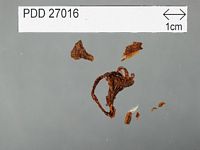
Caption: Dried type specimen
Owner: Herb PDD | 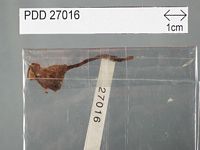
Caption: Dried type specimen
Owner: Herb PDD | |
Article: Horak, E. (1973). Fungi Agaricini Novazelandiae I-V. Beihefte zur Nova Hedwigia 43: 200 p.
Description: Pileus
10-40 mm diam., convex becoming applanate with ± distinct shallow umbilicus
at the centre, margin expanded, dark brown (tobacco), densely covered by concolorous
squamules or (near the centre) scales, striate towards the margin, dry, hygrophanous.
Lamellae (L 10-15, 1 3(7), emarginate adnate, brownish, turning pink-brownish,
gill edge concolorous, not fimbriate. Stipe (25) 30-90 x 2-3.5 mm, cylindrical
or somewhat attenuated towards the base, whitish-brownish, pruinose (at least
apically), stiff, twisted, fragile, dry, fistulose. Context brownish. Odor and
taste none or slightly farinaceous.
Spores
10-12 x 10-12 µm, mostly 5-sided, with prominent knobs, complex. Basidia 30-38
x 10-13 µm, 4-spored. Cheilocystidia (and pleurocystidia) 55-120 x 12-25 µm,
fusoid or ampullaceous, the distinct mucro apically rounded, membrane thin-walled,
hyaline, sometimes coloured by brownish, plasmatic pigment. Caulocystidia 40-85
x 10-20 µm, clavate, hyaline, in clusters. Cuticle a cutis of cylindrical, repent
or suberect hyphae (8-17 µm diam.), membrane thin-walled, not gelatinized, with
brown, plasmatic pigment. Clamp connections abundant.
Habitat: On
soil among mosses and litter in forests (under Beilschmiedia, Weinmannia,
Coprosma, Cyathea, etc.) or on rotten wood (of Nothofagus spp.).
New Zealand.
Notes: Macroscopically,
in its scaly pileus, pruinose stipe and colouring, E. squamiferum resembles
E. acuticystidiosum Hk. but the species can easily be distinguished by
the different size and shape of the spores and the form of the cheilo- and pleurocystidia
respectively.
Article: Horak, E. (1973). Fungi Agaricini Novazelandiae I-V. Beihefte zur Nova Hedwigia 43: 200 p.
Description: Pileus
10-25 mm diam., hemispherical, becoming convex, aged carpophores pulvinate and
often depressed or subconcave at the centre, margin incurved. brown, covered
by soot-brown fibrils and scales, dry, neither striate nor hygrophanous. Lamellae
(L 10-16, l 1-3) adnate-emarginate, whitish when young, becoming grey-pink,
gill edge concolorous, not fimbriate. Stipe 20-40 x 2-3 mm, cylindrical, often
curved near the base, grey or purplish brown, densely covered by concolorous
dots at least near the apex, dry, hollow, solitary or in clusters. Context light
brown. Odor and taste not distinctive.
Spores
12-14 x 11-13 µm, 5-6-sided, with prominent knobs. Basidia 45-52 x 10 µm. 4-spored.
Cheilocystidia 70-110 x 10-20 µm, awl-shaped, membrane thin-walled, hyaline.
pleurocystidia none. Caulocystidia 60-100 x 10µm, clavate, often curved. Cuticle
a cutis of cylindrical, repent or suberect hyphae (10-15 µm diam.), membrane
thin-walled, with conspicuous, brown, plasmatic pigment. Clamp connections present.
Habitat: On
soil in forests (under Dacrydium, Beilschmiedia, Elaeocarpus, Dicksonia,
etc.). New Zealand.
Notes: This
species is distinguished by its large, complex spores, awl-shaped cheilocystidia,
presence of conspicuous caulocystidia and scaly pileus. Macroscopically it resembles
E. squamiferum Hk. (see discussion there).
|